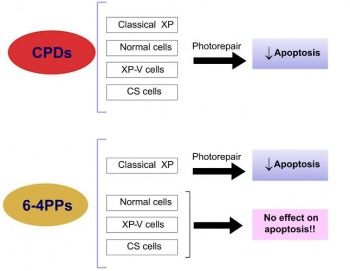Carolina Quayle
From DNA Repair Lab
| Revision as of 14:06, 25 November 2011 Root (Talk | contribs) ← Previous diff |
Current revision Root (Talk | contribs) |
||
| Line 1: | Line 1: | ||
| {| | {| | ||
| |- | |- | ||
| - | |[[Image:Primária.jpg|150px]] | + | |[[Image:Carol.jpg|150px]] |
| |Graduated Biologist and licenced teacher by University of São Paulo (USP) in 2006 and 2009, respectively. PhD student in the Microbiology Department of the Institute of Biomedical Sciences – USP, developing the project entitled “The effect of ultraviolet radiation induced DNA lesions in MEFs and mice knockout for DNA repair genes”. | |Graduated Biologist and licenced teacher by University of São Paulo (USP) in 2006 and 2009, respectively. PhD student in the Microbiology Department of the Institute of Biomedical Sciences – USP, developing the project entitled “The effect of ultraviolet radiation induced DNA lesions in MEFs and mice knockout for DNA repair genes”. | ||
| <br> | <br> | ||
Current revision
| Image:Carol.jpg | Graduated Biologist and licenced teacher by University of São Paulo (USP) in 2006 and 2009, respectively. PhD student in the Microbiology Department of the Institute of Biomedical Sciences – USP, developing the project entitled “The effect of ultraviolet radiation induced DNA lesions in MEFs and mice knockout for DNA repair genes”.
|
|
[edit] Research ProjectThe ultraviolet (UV) component of the sun is the most abundant genotoxic factor present in the environment, inducing two types of photolesion on DNA: the cyclobutane pyrimidine dimer (CPD) and the pyrimidine (6-4) pyrimidone photoproduct (6-4PP). Photolyases are enzymes capable of using the energy of a photon of light to directly convert these dimers back to monomers. These enzymes are absent in placental mammals that count only with the nucleotide excision repair (NER) pathway to remove these double-helix distorting photolesions. Deficiencies in genes involved in this pathway lead to the development of severe syndromes, such as Xeroderma Pigmentosum (XP). Patients with this condition show high photosensitivity and a substantial increase in skin cancer incidence in sun exposed areas. Despite the extensive research that has been done “in vitro” and “in vivo”, the specific role of each photolesion in local e systemic responses such as edema, erythema, apoptosis, tumorigenesis and immunosuppression is still unclear. Based on previous data, from cells proficient and deficient in DNA repair and mice deficient in DNA repair, we suggest that in DNA repair proficient individuals CPD lesions are mostly responsible for tumor induction due to its slow repair. In DNA repair deficient patients 6-4PP lesions must also play an important role due to its bigger double-helix distortion. This project aims to define “in vivo” the specific role of each photolesion in local and systemic responses to UV radiation. To that end XPA knockout mice that constitutively express either CPD-photolyase or 6-4PP-photolyase are daily irradiated with a low UVB dose and their responses are analyzed.

Figure - The effects of photorepair of CPDs and 6-4PPs on UV-induced apoptosis: in NER proficient individuals only CPD removal reduces apoptosis whereas in NER deficient cells CPD and 6-4PP removal is capable of reducing the apoptotic response (adapted from reference 1).
[edit] Main publications1- Quayle C, Menck, CFM, Lima-Bessa, KM (2011) Recombinant viral vectors for investigating DNA damage responses and gene therapy of Xeroderma Pigmentosum. Chapter 6. In DNA Repair and Human Health, ISBN 978-953-307-612-6, edited by Sonya Vengrova, InTech - Open Access Publisher, 145-174. 2- Eker AP, Quayle C,Chaves I, van der Horst GT. DNA repair in mammalian cells: Direct DNA damage reversal: elegant solutions for nasty problems. Cellular and molecular life sciences, 66(6):968-80, 2009. 3- da Costa RM, Quayle C, de Fátima Jacysyn J, Amarante-Mendes GP, Sarasin A, Menck CF.Resistance to ultraviolet-induced apoptosis in DNA repair deficient growth arrested human fibroblasts is not related to recovery from RNA transcription blockage.Mutation Research, 640(1-2):1-7, 2008. 4- Mercuri LP, Carvalho LV, Lima FA, Quayle C, Fantini MC, Tanaka GS, Cabrera WH, Furtado MF, Tambourgi DV, Matos Jdo R, Jaroniec M, Sant'Anna OA. Ordered mesoporous silica SBA-15: a new effective adjuvant to induce antibody response. Small, 2(2):254-6, 2006. |
|